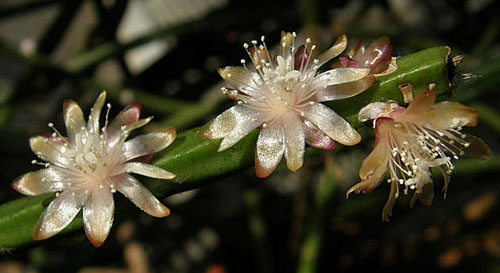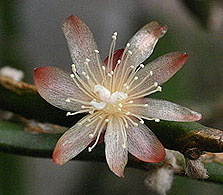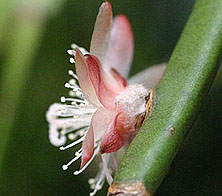Rhipsalis dissimilis (G. A. Lindberg) Schumann in Martius, Fl. Bras. 4(2): 286. 1890



Photos copyright Ken Friedman
Desc from Backeberg 1977 because that in B&R 1920 includes the description of R. pacheco-leoni.
- Body Strongly branching.
- Main stem ribbed or cylindric, to 1cm diam.
- Shoots slender, ribbed, more or less terete, bristly at first.
- Flowers 6 mm wide, borne laterally, white with a pink centre
- Fruit purple, compressed
- Habitat Brazil
Notes
from Bradleya 13.
A possible older name for this species is R. rugulosa Lemaire in
Ill. Hort. 8: unnumbered page after tab. 293 (1861). Its type, which can
be assumed not to have been preserved or illustrated, was erroneously
said to have come from the Greater Antilles (cult. Bot. Gard. Caen, 1861)
and its flowers were not described, but the details given for its stem
and fruit are a reasonable fit for R. dissimilis. It is too
poorly typified to displace the much better known younger name.
The
plant illustrated as R. dissimilis by Britton & Rose (1923)
is here recognized as R. pacheco-leonis Lofgren .
This species is very variable, depending on the habitat in which it occurs.
Its fruits are normally red with a white base, but occasionally they are
almost colourless. The recently described R. spinescens Lombardi
(1993), from exposed rocks in the municipio of Itarare', Sao Paulo state,
is a fertile yet morphologically juvenile phenotype that readily reverts
to the adult stage of R. dissimilis in cultivation. Such neotenic
behaviour is typical of this species.
forma dissimilis
DISTRIBUTION. Brazil (Sao Paulo, Parana): epilithic and epiphytic, seasonal habitats at >800 m altitude.
Desc from Hunt 2006
Branch segments variable and diverse, usually with 5-11 low ribs, sometimes
3-5 angled or nearly terete, 5-14 cm x 4-10mm; areoles at least those
of the ribbed segments with bristly hairs 3-8mm; flowering areoles sunken,
woolly; flower buds tinged red; flowers 10-15mm diam., pale yellow or
greenish; fruit subglobose, 8-10mm diam., pink or purple
-
Comparison photos of R. dissimilis, R. dissimilis var epiphyllanthoides, and Sao Paolo state form